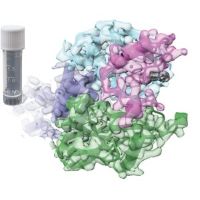Specification
| Organism | Homo sapiens (Human) |
| Expression Host | Baculovirus |
| Tag Info | N-terminal 10xHis-tagged and C-terminal Myc-tagged |
| Purity | Greater than 85% by SDS-PAGE |
| Uniprot ID | P35251 |
| Gene Names | RFC1 |
| Alternative Names | Activator 1 140KDA subunit |
| Expression Region | Partial(402-492aa ) |
| Molecular Weight | 13.8 kDa |
| Protein Sequence | GAENCLEGLIFVITGVLESIERDEAKSLIERYGGKVTGNVSKKTNYLVMGRDSGQSKSDKAAALGTKIIDEDGLLNLIRTMPGKKSKYEIA |
| Form | Liquid or Lyophilization |
| Buffer | The default storage buffer is Tris/PBS-based buffer, 5%-50% glycerol if the delivery form is liquid. The lyophilization buffer is Tris/PBS-based buffer, 6% Trehalose, pH 8.0 if the delivery form is lyophilized powder. Please contact us if you have any special requirment. |
| Reconstitution | Please reconstitute protein in deionized sterile water and we recommend that briefly centrifuge thevial prior to opening the vial .We recommend aliquot for long-term storage at -20℃/-80℃. |
Background
| Relevance | The elongation of primed DNA templates by DNA polymerase delta and epsilon requires the action of the accessory proteins PCNA and activator 1. This subunit binds to the primer-template junction. Binds the PO-B transcription element as well as other GA rich DNA sequences. Could play a role in DNA transcription regulation as well as DNA replication and/or repair. Can bind single- or double-stranded DNA. Interacts with C-terminus of PCNA. 5' phosphate residue is required for binding of the N-terminal DNA-binding domain to duplex DNA, suggesting a role in recognition of non-primer template DNA structures during replication and/or repair. |
| Involvement in Disease | |
| Subcellular Location | Nucleus |
| Protein Families | Activator 1 large subunit family |
| Tissue Specificity | RFC1 |
QC Data
| Note | Please contact us for QC Data |
| Product Image (Reference Only) |  |

